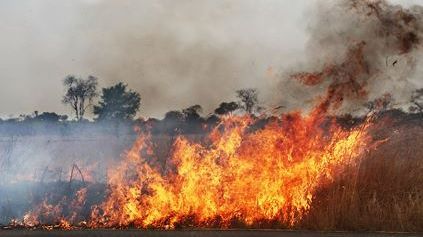Windy, dry conditions fueled grass fires that burned hundreds of acres in south-central Kansas in late March and early April. The flames are a stark reminder of the potentially catastrophic danger grass fires pose to farmland, machinery, buildings and other high-value assets.
Plan ahead to prepare for a grass fire and know what to do when one threatens your farm. That starts with staying informed. Stay abreast of conditions that can favor a fire and when the National Weather Service (NWS) issues Fire Weather Watches or Red Flag Warnings.
Though they vary by region, sustained high winds and low humidity are the most frequent conditions considered in issuing the watches and warnings. A watch is issued up to 72 hours before they’re expected, while a Red Flag Warning is issued when they’re likely within 24 hours. Don’t take such alerts lightly. A grass fire can quickly overwhelm farm vehicles, buildings and their occupants.
“Grass fires can move very quickly; 10-14 mph is not unheard of in windy conditions,” said Nationwide Risk Management Consultant and Agronomist Derek Hommer. “If a Red Flag Warning is issued, make every effort to control hazards like burning trash or using power tools that create sparks. Be vigilant for signs of smoke or fire.”
Other tips to prevent fire and stay safe when conditions favor a grass fire near your farm are:
- Plan ahead and loop in everyone. Work with farm workers, family members, local fire department personnel and anyone else who’s on or around your farm to plan for any fire containment or emergency evacuation efforts. This may include plans to relocate equipment, machinery or livestock that could be caught in a grass fire.
- Don’t count on the road. Though they sometimes form a break in vegetation that can fuel a fire, flames can often “jump” a roadway and continue its spread. Never depend on a roadway to stop a grass fire.
- Relocate or remove flammable materials. Take an inventory of any materials on your farm that could propel a grass fire, including hay bales, stored fuel and other similar combustibles. Make sure these types of highly flammable materials aren’t situated close to barns, outbuildings or farm homes to reduce the risk of structural damage.
- Prepare for containment. Keep a tillage tool hooked up and ready, as tilling a fire break in grass in the fire’s path can sometimes stop it. “If the terrain doesn’t provide that opportunity, a ready supply of extra water and shovels can be helpful,” Hommer said.
- Consider fire year-round. Even outside the traditional “fire season,” don’t take fire safety lightly. Post signs and enforce safety procedures and practices around your farm. Also make sure you have all the necessary safety equipment — smoke alarms, fire extinguishers, sprinkler systems — well-maintained and ready at all times.
“Consider everything your home, family, farm equipment and livestock will need in the event a grass fire hits your farm,” Hommer said. “Make sure you have emergency action plans made well in advance of fire season.”
